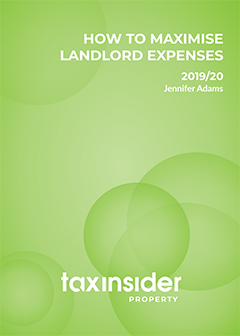The below excerpt is taken from our popular property report How to Maximise Landlord Expenses. 
Property owners become landlords for a variety of reasons but one thing that they all have in common is the desire to maximise rental income profits and/or capital growth from their property investment. A common mistake is to think that the only way that this can be achieved is by increasing the rent to as high a level as the market can take but this might not be practical, depending on a variety of reasons.
Revenue v capital expenses
Sometimes it might be preferable for an expense to be deemed as capital if a property has been purchased because of the likely capital appreciation.
However, it is invariably better for the expense to be of income in nature rather than capital, if possible, as tax relief for revenue expenses is allowed in the tax year of payment, whereas if an expense is deemed to be capital then the claim is deferred until the property is sold, which might be some years in the future.
Sometimes, there is a thin dividing line as to what constitutes an ‘income’ expense in comparison with a ‘capital’; the following ‘tests’ may be of help.
Test 1: Alteration, improvement, replacement
Capital costs include the cost of purchase of the land and building itself, plus any refurbishment expenses that are not straight forward repairs. In general, when work is carried out to an existing or newly acquired property which results in the asset being altered, improved or upgraded, then such costs are normally ‘capital’ in nature and should be disallowed in calculating the rental profit or loss for income tax purposes. Improvements or the replacement of an entire asset will be capital. An example of a capital expense would be the creation of an ensuite bathroom where there was none initially.
Expenses will be revenue if they constitute repairs or the replacement of part of an asset. Examples include: replacing kitchens and bathrooms, re-wiring, decorating, repairing roofs and gutters, etc.
See Chapter 5 for more detail.
Test 2: ‘wholly and exclusively’
There are, in fact, very few expenses incurred on the letting of property that are disallowed from a claim of being either of revenue or capital expenditure. However, just because a payment has been made does not necessarily mean that it will be allowable. Strictly, for an expense to be allowed the business purpose must be the sole purpose; there must be no dual reason for the expense. The expenses must be ‘wholly and exclusively’ incurred for the purposes of renting out the property; if not, then the expense cannot be deducted. Where it is difficult to split the business element from any private element then the whole expense amount is usually disallowed, however, where the distinction can be made then the private element is disallowed, as shown in this example.
The following is an example of where partial relief can be claimed.
Example 6: Partial relief
Jodie has an investment property. One tenant leaves, and to attract another, she decides that the bathroom needs updating and so she decides to replace the tiles.
The local tile shop has an offer of 12 square metres of tiles for £240 but only eight square metres is needed for the bathroom. She decides that her bathroom could also do with an ‘up-lift’ so she purchases the tiles and uses the extra four square metres for her use. This means that the entire cost has not been incurred ‘wholly and exclusively’ for the rental property. However, a portion of the cost has. She can, therefore, claim £160 (i.e. two-thirds of £240) against the rental income.
In practice, however, some ‘dual-purpose’-type expenses may be permitted. The expense usually quoted is of expenses incurred in the running of a car used partly for business and partly for private purposes, the business part being allowed. The cost of business-related travel in attending to rental properties is as an expense for tax purposes, but any travel costs incurred for personal reasons are not (see section 3.4 for more detail).
If a property is let at no rent or less than a commercial rent (e.g. to a relative), HMRC considers that the expenditure relating to that property is likely to fail the ‘wholly and exclusive’ test. Strictly, no expenditure should be allowable, however, in practice, HMRC will allow expenses to deductible up to the amount of rental received.
To get the full scoop and more tips, purchase the full report here:




